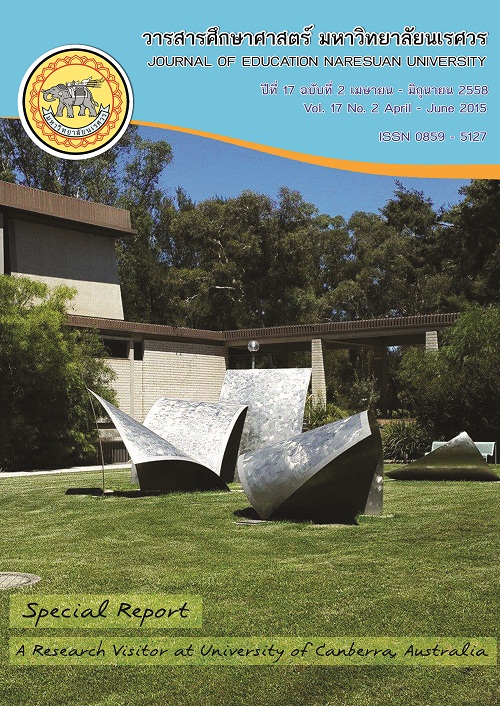Learner Autonomy on English Learning of Mattayom Suksa 6 Students
Main Article Content
Abstract
บทคัดย่อ
วัตถุประสงค์ของงานวิจัยนี้คือเพื่อ 1) ตรวจสอบความสามารถในการเรียนรู้ภาษาอังกฤษด้วยตนเองของนักเรียนมัธยมศึกษาปีที่ 6 และ 2) ศึกษาความสัมพันธ์ระหว่างความสามารถฯ กับเพศ เกรดเฉลี่ยสะสม วิธีเรียนเชิงลึกและผิวเผิน เป็นงานวิจัยเชิงสำรวจใช้แบบสอบถามเก็บข้อมูลกับนักเรียนชั้นมัธยมศึกษาปีที่ 6 จำนวน 178 คน วิเคราะห์ข้อมูลด้วยสถิติเชิงพรรณนาและการวิเคราะห์ถดถอยพหุเชิงเส้น ผลการวิจัยตามวัตถุประสงค์ข้อ 1 พบว่า โดยเฉลี่ย นักเรียนมีความสามารถฯ ในระดับสูง (ค่าเฉลี่ย 3.57, ค่าเบี่ยงเบนมาตรฐาน .41) ส่วนวัตถุประสงค์ข้อ 2 พบว่าตัวแปรอิสระที่มีผลต่อความสามารถฯ อย่างมีนัยสำคัญทางสถิติที่ระดับ .05 และ .01 คือ เกรดเฉลี่ยสะสม (β = .14, p = .03) วิธีเรียนเชิงลึก (β = .63, p = .00), วิธีเรียนเชิงผิวเผิน (β = -.19, p = .01) ส่วนตัวแปรเพศไม่มีผลต่อความสามารถฯ (β = -.11, p = .09) ตัวแปรอิสระทั้งหมดมีค่าความสัมพันธ์กับความสามารถฯ ในระดับปานกลาง (R= .60) และอธิบายความสามารถฯ ได้ร้อยละ 35.6 (R2= .36) เมื่อพิจารณาลำดับความสำคัญของตัวแปรอิสระที่มีผลต่อความสามารถฯ พบว่า วิธีเรียนเชิงลึกมีผลมากที่สุด รองลงมาคือวิธีเรียนเชิงผิวเผิน ซึ่งมีความสัมพันธ์ในทางลบ และเกรดเฉลี่ยสะสมมีผลน้อยที่สุด
คำสำคัญ: ความสามารถการเรียนรู้ด้วยตนเอง/ การเรียนภาษาอังกฤษ/ นักเรียนมัธยมศึกษาปีที่ 6
Abstract
This study aimed to 1) investigate learner autonomy of Mattayom Suksa 6 or Grade 12 students, and 2) examine the relationship between learner autonomy and gender, GPA, deep and surface learning approaches. It took the form of survey research employing questionnaires to gather data from 178 Mattayom Suksa 6 students. Data were analysed using descriptive statistics and multiple regression analysis. In response to research objective 1, it was found that, on average, learner autonomy of students was at a high level (M = 3.57, SD = .41). The findings of research objective 2 revealed that the independent variables that had the effects on learner autonomy at significant levels of .05 and 0.01 were GPA (β = .14, p = .03) a deep learning approach (β = .63, p = .00), and a surface learning approach (β = -.19, p = .01). Gender had no effect (β = -.11, p = .09) on autonomy. All of the independent variables had a moderate correlation with learner autonomy (R = .60) and collectively could explain a learner autonomy level with 35.6% (R2= .36). Considering the effect of each independent variable on autonomy in a ranking order, it was found that a deep approach was the most influential factor, followed by a surface learning approach with a negative relationship, and GPA.
Key words: Learner autonomy/ English learning/ Mattayom Suksa 6 studentsArticle Details
The owner of the article does not copy or violate any of its copyright. If any copyright infringement occurs or prosecution, in any case, the Editorial Board is not involved in all the rights to the owner of the article to be performed.


